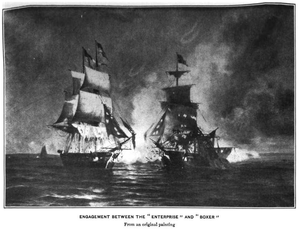HMS Boxer (1812)

Enterprise and Boxer
|
|
| History | |
|---|---|
|
|
|
| Name: | HMS Boxer |
| Ordered: | 16 November 1811 |
| Builder: | Hobbs & Hellyer, Redbridge, Hampshire |
| Launched: | 25 July 1812 |
| Captured: | 5 September 1813 by USS Enterprise near Portland, Maine |
|
|
|
| Name: | Boxer |
| Route: | North Atlantic, West Indies |
| Fate: | Sold as a Portuguese mail packet in 1818 |
|
|
|
| Fate: | Possibly lost on the coast of Brazil |
| General characteristics | |
| Class and type: | Bold-class gun-brig |
| Tons burthen: | 181 67⁄94 (bm) |
| Length: |
|
| Beam: | 22 ft 1 in (6.7 m) |
| Depth of hold: | 11 ft (3.35 m) |
| Sail plan: | Brig |
| Crew: | 60 |
| Armament: | 10 x 18-pounder carronades + 2 x 6-pounder bow chasers |
HMS Boxer was a 12-gun Bold-class gun-brig built and launched in July 1812. The ship had a short service history with the British Royal Navy before the 16-gun USS Enterprise captured her near Portland, Maine in September 1813. She then went to have at least a decade-long commercial career.
The Bold class were a revival of Sir William Rule's Confounder-class gun-brig design of 1804. They were armed with ten 18-pounder carronades and two 6-pounder bow chasers. Built by Hobbs & Hellyer, Redbridge, Hampshire, she was launched on 25 July 1812.
Commander George Rose Sartorius commissioned her in August 1812. R. Coote may have briefly commanded her before Commander Samuel Blyth took command in September; on 17 April 1813 she sailed for Halifax and service in the squadron of Sir John Borlase Warren. In Halifax, Blyth added two extra carronades to her armament. She therefore actually carried fourteen guns: twelve 18-pounder carronades and two long 6-pounders.
While coming down from New Brunswick and off the coast of Lubec, Maine, Blyth sighted and captured a small sailing craft crewed by a group of women out for a sail. He brought the women aboard and politely suggested that in the future they sail closer to the shore; he then released them. One of the women was married to the local militia commander who, impressed with Blyth’s courtesy, placed advertisements in local newspapers praising his chivalry.
In Boxer Lieutenant Blyth captured seven small vessels, most of them coasting:
On 5 September Boxer engaged the American brig Enterprise under Lieutenant William Burrows. Blyth nailed his colours to the mast and died in the first broadside. The same broadside that killed Blyth dismasted Boxer. Boxer continued to fight for another half an hour before she was forced to strike. Enterprise carried two more guns, had a heavier broadside, and had almost twice the number of men. However, the key factor was the dismasting of the Boxer, which allowed Enterprise to maneuver to rake her. Furthermore, a court martial later found that a number of British seamen had deserted their quarters during the action.
...
Wikipedia
